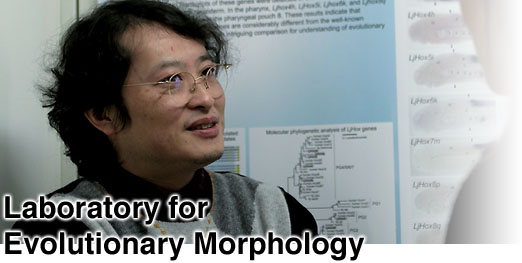





      |

By studying the evolutionary designs of diverse species, I hope to gain a deeper insight into the secrets behind the fabrication of the vertebrate body. Integrating the fields of evolutionary morphology and molecular genetics, our lab seeks to expand the understanding of the relationship between genome and morphology (or body plan) through investigating the evolutionary changes in developmental processes. Our recent studies have focused on traits of the vertebrate head region, especially the jaw, as well as the turtle shell. By analyzing the history of developmental patterns, I hope to open new avenues toward answering as-yet unresolved questions about vertebrate development.
Through the study of evolutionarily novel structures, our lab has identified changes in developmental mechanisms that have obliterated the structural homologies between organisms as evidenced in such novel structures as the gnathostome (jawed fish) jaw and the turtle shell. Study of lamprey jaw development is intended to shed light on the true origins of the vertebrate head, as lampreys lack a number of important features, such as jaws, that are possessed by gnathostomes. We aim to resolve the question of what primary factors that have changed during evolution by comparing the developmental patterns that yield such innovations, and by the experimental construction of phenocopies in one animal that mimic structures in another.
The turtle's shelled body pattern appears suddenly in the fossil record. Our lab's research into turtle carapace development addresses the developmental changes that resulted in this abrupt and dramatic morphological change, and is aimed at identifying genes that function differently in chicken and turtle, which it is hoped will provide a key to discovering the true targets of natural selection in acquisition of a shell.